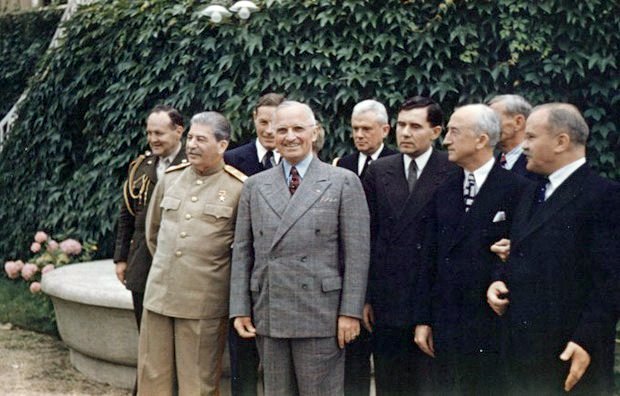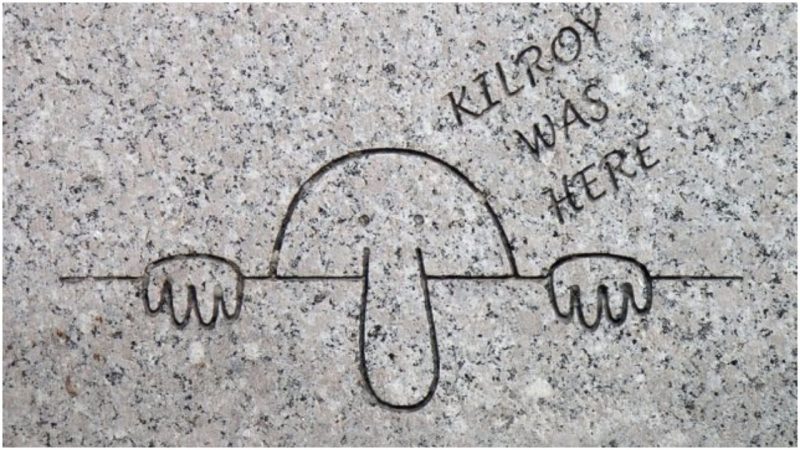Most people link the origins of modern graffiti art with the first popular tagger from New York City, TAKI 183. During the late 1960s, his nickname screamed from the previously untainted facades, transforming walls into notebooks and making him probably the most influential graffiti artist of all times. But the first truly viral meme broke through two decades before – among US soldiers. Kilroy was here.
Where exactly was Kilroy? Basically, everywhere the US forces went; you’d find his signature wherever they were stationed, encamped, or visited. And next to it, a doodle of a bold guy with a large nose peeking behind a wall.
To the outsiders – especially the Axis troops – it must have seemed kind of creepy, even threatening. To the American public, who found out about the mysterious character via newspapers, it was a morale boost. Kilroy was everywhere, a superhero, a guardian hovering among our boys.
Ok, but who was the actual bearer of this killing name. Even though there are some rather interesting theories, no one really found out. And as the war dragged on, the mystery was reaching new heights.

At one point, Gestapo captured some US equipment and there it was – the notorious scribble. This prompted Hitler to believe that Kilroy was an Allied spy’s codename. Even as late as 1945, the tag would gain the attention of Joseph Stalin. He stumbled across the meme while taking a wee in the Cecilienhof Palace, during the Potsdam Conference.
The most convincing – and materially grounded – theory attributes the meme to one James J. Kilroy. James was a shipyard inspector. During WWII, James worked at the Fore River Shipyard in Quincy, Massachusetts. Among other stuff, a shipyard inspector’s job was to check on the riveters. Their job, in turn, was, well, to place rivets on boats.
Since a builder’s wage depended on the number of rivets they’d installed, some would try to cheat at the expense of their colleagues. Thus they would erase a chalk mark their precursor drew next to his last placed rivet and chalk a new mark farther back on the same seam – taking credit for someone else’s labor.
Mr. Kilroy was said to have found a way to put an end to this mischievous practice. While inspecting, he would inscribe “Kilroy was here” at each chalk mark. Simple as that. And once the sailors opened up the sealed areas for ship maintenance, they would often be greeted by an unexpected stranger.
The rumor spread like wildfire, and Kilroy soon became a Navy legend. Since Kilroy checked the places where seemingly no one else has been before, his omnipresence became a sort of talisman in such hard times. It is possible that this meaning further evolved so as to represent the protection the US troops gave to the liberated territories.
But, was James J. Kilroy bald and beaky? Not really. The accompanying doodle came about as a sort of collaboration among the Allied forces. It’s not hard to imagine that every country had their own Kilroy. Thus, Australians had Foo, Brits had Chad, various European nations had Smoe, M. Pulina, Józef Tkaczuk, Vasya, etc. But one stood out. Chad.
Chad was a popular wartime doodle in the UK, lamenting over food shortages and rationing. He would appear next to the phrase “Wot, no sugar/milk/bread/etc”, with a single curling hair shaped into a question mark. Chad resembles various cartoon characters but is probably a cousin of Chat, a 1938 doodle by a famous British cartoonist George Edward Chatterton.
Either way, the Brits did the drawing, while the Americans took care of the copyright. With more important things at hand, they never dreamed that they were simultaneously taking part in the first viral meme ever to traverse the globe – long before the age of the Internet.
